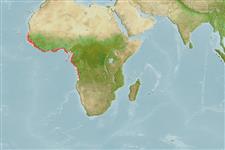Environment: milieu / climate zone / depth range / distribution range
Ecologia
marinhas demersal; intervalo de profundidade 80 - 300 m (Ref. 3589). Tropical; 17°N - 13°S, 19°W - 15°E (Ref. 5222)
Eastern Atlantic: Mauritania (Ref. 5377) and Senegal to southern Angola.
Tamanho / Peso / Idade
Maturity: Lm ? range ? - ? cm
Max length : 140 cm TL macho/indeterminado; (Ref. 5377); common length : 50.0 cm TL macho/indeterminado; (Ref. 26999)
Espinhos dorsais (total): 11; Raios dorsais (total): 16; Espinhos anais 3; Raios anais : 8. Distinguished by the following characteristics: brownish head and body; 3-4 broad oblique bars on the dorsal part of the body and another on the dorsal half of the peduncle; 2 narrow faint dark bands extending posteriorly from the lower half of the eye; presence of dark moustache streak, not extending past the rear end on maxilla; body depth less than head length, depth contained 2.9-3.2 times in SL; head length 2.5-2.7 times in standard length; flat or slightly convex interorbital area; angular preopercle, 3-4 enlarged serrae at the angle, lowermost directed ventrally; serrate interopercle and subopercle; well developed middle and lower opercular spines, upper spine not apparent; approximately straight upper edge of operculum; maxilla reaches vertical at rear edge of eye; maxilla naked or with few minute scales dorsally; 2 rows of teeth on midlateral part of lower jaw; posterior nostril about twice the size of anterior nostril (Ref. 89707).
Reported to occur from a variety of habitats (rock, mud and sand). The adults live in relatively deeper waters (Ref. 5377). Little is known about its biology.
Ciclo de vida ou comportamento de acasalamento
Maturidade | Reprodução | Desova | Ovos | Fecundidade | Larvas
Heemstra, P.C. and J.E. Randall, 1993. FAO Species Catalogue. Vol. 16. Groupers of the world (family Serranidae, subfamily Epinephelinae). An annotated and illustrated catalogue of the grouper, rockcod, hind, coral grouper and lyretail species known to date. Rome: FAO. FAO Fish. Synop. 125(16):382 p. (Ref. 5222)
Status na Lista Vermelha da UICN (Ref. 130435)
Ameaça para os humanos
Harmless
Uso pelos humanos
Pescarias: pesca de subsistência
Mais informação
Nomes comunsSinônimosMetabolismoPredadoresEcotoxicologiaReproduçãoMaturidadeDesovaAgregação de desovaFecundidadeOvosDesenvolvimento dos ovos
ReferênciasAquaculturaPerfil para aquaculturaEstirpesGenéticaElectrophoresesHereditariedadeDoençasProcessamentoNutrientsConversão de massa
ColaboradoresFotosStamps, Coins Misc.SonsCiguateraVelocidadeTipo de nataçãoÁrea branquialOtólitosCérebrosVisão
Ferramentas
Relatórios especiais
Baixar XML
Fontes da internet
Estimates based on models
Preferred temperature (Ref.
123201): 14.2 - 16.4, mean 15.3 °C (based on 16 cells).
Índice de diversidade filogenética (Ref.
82804): PD
50 = 0.5000 [Uniqueness, from 0.5 = low to 2.0 = high].
Bayesian length-weight: a=0.01072 (0.00585 - 0.01962), b=3.03 (2.88 - 3.18), in cm total length, based on LWR estimates for this species & Genus-body shape (Ref.
93245).
Nível Trófico (Ref.
69278): 3.9 ±0.64 se; based on food items.
Resiliência (Ref.
120179): médio(a), tempo mínimo de duplicação da população 1,4 - 4,4 anos (Assuming tm=3-4).
Fishing Vulnerability (Ref.
59153): Very high vulnerability (84 of 100).
Climate Vulnerability (Ref.
125649): Very high vulnerability (83 of 100).
Nutrients (Ref.
124155): Calcium = 42.3 [16.9, 97.0] mg/100g; Iron = 0.731 [0.329, 1.668] mg/100g; Protein = 17.7 [16.0, 19.2] %; Omega3 = 0.187 [0.095, 0.360] g/100g; Selenium = 97.9 [44.0, 230.9] μg/100g; VitaminA = 30.3 [7.3, 126.4] μg/100g; Zinc = 1.03 [0.64, 1.70] mg/100g (wet weight);
